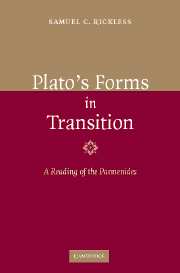Book contents
- Frontmatter
- Contents
- Preface
- List of abbreviations
- Introduction
- Chapter 1 The theory of forms
- Chapter 2 The theory criticized
- Chapter 3 The theory modified: methodology
- Chapter 4 The First Deduction
- Chapter 5 The Second Deduction
- Chapter 6 From the Appendix to the Fourth Deduction
- Chapter 7 From the Fifth to the Eighth Deduction
- Conclusion
- References
- Index of forms discussed
- Index of Deductions
- Index of passages cited
- General index
Chapter 6 - From the Appendix to the Fourth Deduction
Published online by Cambridge University Press: 22 September 2009
- Frontmatter
- Contents
- Preface
- List of abbreviations
- Introduction
- Chapter 1 The theory of forms
- Chapter 2 The theory criticized
- Chapter 3 The theory modified: methodology
- Chapter 4 The First Deduction
- Chapter 5 The Second Deduction
- Chapter 6 From the Appendix to the Fourth Deduction
- Chapter 7 From the Fifth to the Eighth Deduction
- Conclusion
- References
- Index of forms discussed
- Index of Deductions
- Index of passages cited
- General index
Summary
Immediately after the first two Deductions, Parmenides begins a new stretch of reasoning (155e4–157b5) that initially appears to be a Third Deduction. As he puts it at 155e4: “Let's speak of it [i.e., the one] yet a third time.” But appearances are misleading. This stretch of five arguments comprises what would be better described as an “Appendix” to the first two Deductions. There are two main reasons for this. First, the Appendix does not fit into the overall description of the Deductions provided by Parmenides in the transitional section. Rather, what Parmenides there counts as the material one would expect to find in the Third Deduction (namely, arguments leading to results about the others on the supposition that the one is) actually appears immediately after the Appendix (at 157b6–159b1). Second, Parmenides begins the Appendix by saying (at 155e4–6): “If the one is as we've described it – being both one and many and neither one nor many …” This makes it rather clear that Parmenides means to use the section to consider consequences that may be obtained from results reached in the first two Deductions. For it is in D2 that Parmenides establishes that [if the one is, then] the one is many (D2A3, D2A5), and it is in D1 that Parmenides establishes that [if the one is, then] the one is not one (D1A17) and not many (D1A1).
- Type
- Chapter
- Information
- Plato's Forms in TransitionA Reading of the Parmenides, pp. 188 - 211Publisher: Cambridge University PressPrint publication year: 2006



